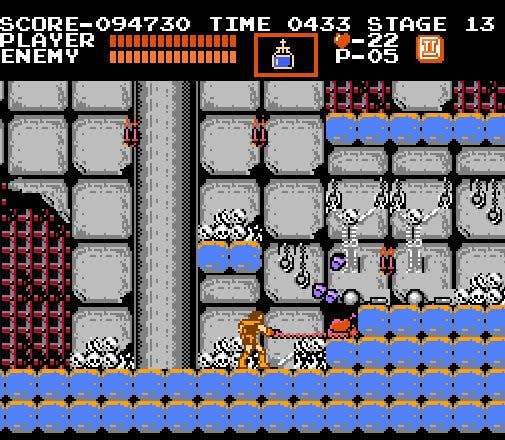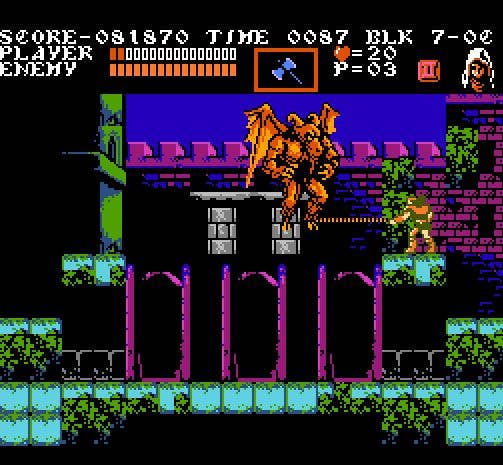5 Cool Retro Castlevania Facts You Didn't Know in Honor of Castlevania Anniversary Collection's Release
What NES sprites have to teach us about the darkness in men's hearts, and more philosophy delivered in 8-bits.
This article first appeared on USgamer, a partner publication of VG247. Some content, such as this article, has been migrated to VG247 for posterity after USgamer's closure - but it has not been edited or further vetted by the VG247 team.
Castlevania Anniversary Collection was uncaged today, and it's currently stalking the PlayStation 4, Xbox One, Switch, and PC with the fervor of a werewolf hunting under a full moon. The Collection grants us a good opportunity to look back on these super-retro titles and observe how they were shaped.
Supplementary game trivia and developer stories from these long-ago and far-away times is rare, and extremely welcome. Interview translation site Shmuplations recently gifted Castlevania fans with a real treat when it gathered, translated, and published several tweets, interviews, 2ch threads, and other bits of information from retro Castlevania's developers and directors. The post is a treasure trove of Castlevania information. It's meatier than anything Simon or Trevor Belmont ever dug out of a wall.
There are five particular facts that stand out for me as a veteran Castelvania fan:
Simon is hunched-over to signify he's always ready to strike
Simon and his ancestor, Trevor have terrible posture in their 8- and- 16-bit adventures. They're perpetually hunched over, as if Dracula cursed their bloodline with chronic osteoporosis. Fear not, though. The Belmonts are not in pain (well, barring the emotional and physical agony that comes with hunting Dracula's minions across centurties). According to retro Castlevania creator/director, Hitoshi Akamatsu, they're just ready to strike.

An anonymous developer who worked on a PlayStation fishing game under Akamatsu says, "One time, when I was talking with Akamatsu about the right stance for casting a fishing line (for our development of [the PlayStation fishing game] Tsuridou), it suddenly occurred to me to ask him, 'By the way, why does Simon have that hunchback posture?' To which Akamatsu replied, 'Because he’s always ready to strike with his whip!'"
When the developer asked why the Akamatsu put whips in the Belmonts' hands to begin with (most NES heroes used guns or swords), Akamatsu said whips are good for repelling enemies—plus, he was just a big fan of Raiders of the Lost Ark. "I want my hero to be like Indy!" is as good as reason as any.
You encounter the sub-weapons in a specific order in Castlevania, and that's by design
Retro Castlevania games are still infamous for their brutal difficulty (though the challenge was jacked up rather unfairly for Western audiences), but Simon has the tools he needs to succeed. Besides his whip, Simon can find sub-weapons like the Dagger and Stopwatch, as well as the powerful Axe, Cross, and Holy Water.
The same anonymous developer says in the first Castlevania game, Akamatsu introduced players to the Dagger to get them used to using sub-weapons. They progress to stronger sub-weapons from there. "[Akamatsu] made the stopwatch so you could get used to enemy attacks. Then the strongest items are the Cross and the Holy Water. And that was how he determined the order in which the items would appear to the player."
The monster you fight at the end of Castlevania isn't Dracula
When you beat Dracula's human form in the first Castlevania game, he turns into a strange demon-bat and challenges Simon to round two. Multi-stage Dracula fights became a staple in subsequent Castlevania games. Rondo of Blood (and by extension, the opening of Symphony of the Night) even re-visit the idea of Dracula's demon-bat form.
Interestingly, Dracula's second form isn't merely an evolution of the evil Count. It's supposed to be an "incarnation of the curse of man."
"That’s why when Simon defeats [the incarnation], he gets cursed. Like most people, I thought that was just a powered-up monster form of Dracula, and I joked as much in front of Akamatsu one day," says the anonymous developer. "He completely refuted that idea though. (laughs) 'That is a monster borne from the curse of man.' He added, 'In a truly peaceful age, Dracula would not exist.'"
As Shmuplations points out, later Castlevania games explore how Dracula's repeated resurrections are a direct cause of the darkness in men's hearts. It's like Drac himself philosophizes: "What is a man? A miserable little pile of secrets!"
The clock tower is directly tied to Dracula's well-being
Love Castlevania, love its clocktower levels. That's the rule. Seems every Castlevania game has a level where Simon (or Trevor, or Richter, or Alucard, or—) needs to avoid being ground up into hamburger by whale-sized clocktower gears. Akamatsu seemingly always intended for the clocktower to be of great importance to Dracula.

"Akamatsu also explained to me how the rotating gears in Dracula’s castle represent Dracula’s heart. They turn so long as Dracula is alive," says the anonymous developer. "That’s why, in the ending of Castlevania, the clock tower collapses, but the rest of the castle remains—Akamatsu said he intended that as a hint towards a sequel. It’s sort of his nod to horror movies, I think."
The Castlevania 3: Dracula's Curse team pushed themselves to outdo the Teenage Mutant Ninja Turtles team
Though the first three Castlevania games enjoy a great legacy, they weren't massive sellers when they first came out. Konami prioritized games that sold well, particularly games based on its Teenage Mutant Ninja Turtles license. Teenage Mutant Ninja Turtles for the NES arrived in 1989 at the height of Turtle-mania, and went on to sell over 4 million copies. The success of the Turtles and Konami's subsequent shunning of the Castlevania team pushed Akamatsu to make Castlevania 3 a stand-out title.
"During the Famicom era at Konami, the overseas sales for Turtles was Konami’s highest seller, and because of that, the Turtles development team was prioritized above everything else," says the anonymous developer. "The Castlevania team (and others like it which didn’t make a lot of money) had to survive on the scraps. There was a possibility for further Castlevania sequels on the Famicom, but it got pushed out by the popularity of Ninja Turtles."
Sadly, despite Akamatsu's vision and talent as a director, the so-so sales of the first three Castlevania titles got him demoted to one of Konami's game centers until he quit. His only known post-Castlevania credit is for the aforementioned Tsuridou fishing game for the PlayStation.

Hopefully Hitoshi Akamatsu has an idea of how much the kids who grew up with his games still love them. There are more than a few of us who intend to spend this weekend playing the Castlevania Anniversary Collection. What better day to throw Holy Water in vampires' faces than the Lord's day?


